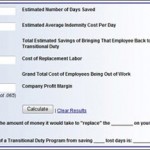Bring Employees Back to Work Sooner The fundamental reason WC Costs are too high is: Too Many Employees are Out of Work Too Long Return to work programs focus on bringing employees back to work as soon as they are medically able. Employees who are out of work receive more medical treatment, so reducing lost …
Return-to-Work & Transitional Duty
Federal Employees Return-to-Work (Part 1): Transitional Work (before Maximum Medical Improvement)
What time period do these questions address? These questions cover the time period from when an injury or occupational illness is reported to the time when a recovering employee is determined to have reached the point of Maximum Medical Improvement (MMI). Read More: Industry and Transitional Duty for Federal Government Lowering Work Comp Costs for …
Federal Employees Return-to-Work (Part 2): Alternative Employment (after Maximum Medical Improvement)
What is meant by alternative employment? Alternative employment means a job other than the injured employee’s job at the date of injury. Alternative employment is used here to describe work that can be performed by an individual who has reached the point of maximal medical improvement (MMI) but is no longer physically able to perform …
Free Transitional Duty Cost Calculator
Will bringing an employee back to work sooner save your company money? Absolutely! Our RTW Cost Savings Calculator shows how much your company can save by bringing employees back to work sooner. Track your transitional duty savings each and every month. Use this quick and easy-to-use tool to show management how much your transitional duty …
Transitional Duty Cost Calculator
Estimated Number of days saved Estimated Average Cost per Day x Total estimated savings of briging that employee back to work on transitional duty = _____ Cost of Replacement Labor + Grand Total Cost of Employees out of work = _____ Profit Margin(%) / 6.5 not 0.065 Calculate Clear Results Grand Total : $0.0 $ …
Local Rx: Developing Return-to-Work Programs in Unionized Companies
By Rebecca A. Shafer – July 2009 Collective bargaining obligations, labor contract requirements and uncooperative unions can be hindrances for a unionized company that is trying to develop a return-to-work program to manage workers compensation costs. Unions often oppose a return-to-work program until they can be convinced that it offers them something. Sometimes, employers facing this situation drop the idea completely, believing the obstacles are too great. The …





